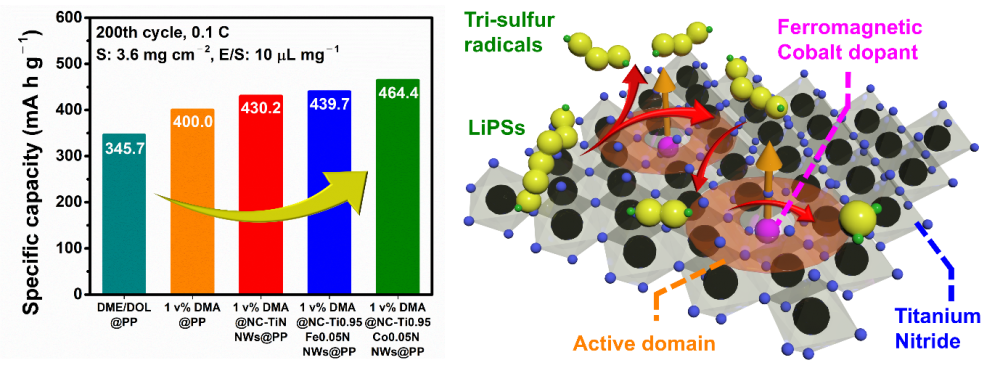
연구
Research Outcome
미래를 창조하는 포스텍 화학공학과
Activation of the Radical-Mediated Pathway and Facilitation of the Li2S Conversion by N-Doped Carbon-Embedded Ti1-xCoxN Nanowires as a Multifunctional Separator with a High Donor-Number Solvent toward…
- Title of paper
- Activation of the Radical-Mediated Pathway and Facilitation of the Li2S Conversion by N-Doped Carbon-Embedded Ti1-xCoxN Nanowires as a Multifunctional Separator with a High Donor-Number Solvent toward Advanced Lithium-Sulfur Batteries
- Author
- [김원배 교수님 연구실] 차세대 Li-S 이차전지의 효과적인 Li2S 전환을 위한 촉매 개발
- Publication in journal
- Small Struct. 2024, 5, 2400293
- Publication date
- 20240814
[Abstract]
Electrolyte modification with a high donor-number solvent is necessary to increase sulfur utilization, but it also presents poor compatibility with lithium metal. The amount of the solvent should be optimized to maximize sulfur utilization at the cathode and minimize side reactions with Li metal at the anode. An electrolyte solution comprising 1 vol% N,N-dimethylacetamide (DMA) in a 1,2-dimethoxyethane (DME)/1,3-dioxolane (DOL) co-solvent demonstrated increased discharge capacity and reduced overpotential compared to DME/DOL and DMA/DOL. In addition to electrolyte, modification that creates radical-mediated pathways from a high donor-number solvent, long-cycle performance is achieved by effectively mitigating the shuttling effect and enhancing reaction kinetics with an efficient electrocatalyst. Cobalt doping into TiN introduced an upshift of the d-band center with ferromagnetic properties that suppressed the shuttling effect, activated radical-mediated pathways, and facilitated the Li2S conversion. A multifunctional separator fabricated with N-doped carbon-embedded cobalt-doped titanium nitride nanowires (NC-Ti0.95Co0.05N NWs) under 1 vol% DMA electrolyte achieved a discharge capacity of 464.4 mA h g−1 even after 200 cycles at a decay rate of 0.093% per cycle through the synergistic effects of electrolyte and electrocatalyst modifications. This work highlights the importance of ferromagnetic catalysts with a high donor-number solvent for lithium–sulfur (Li–S) batteries.




